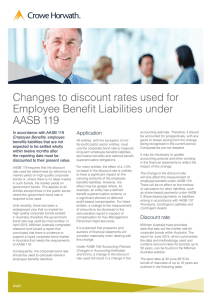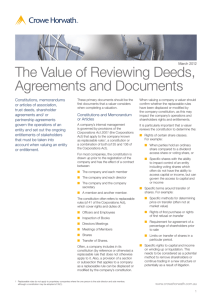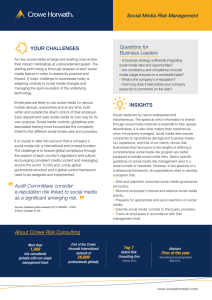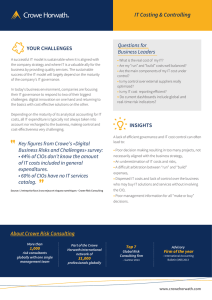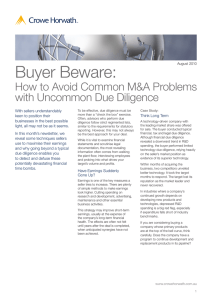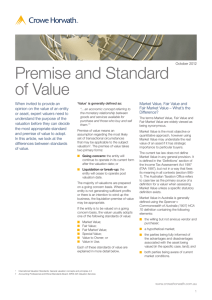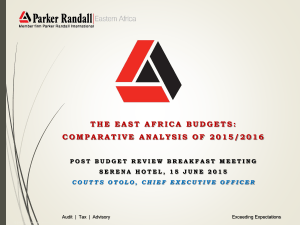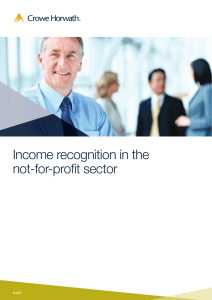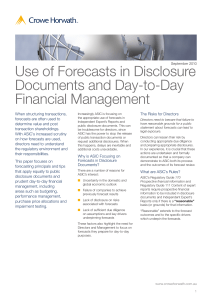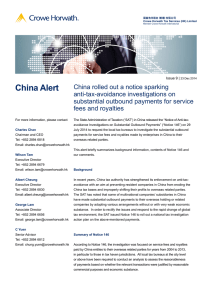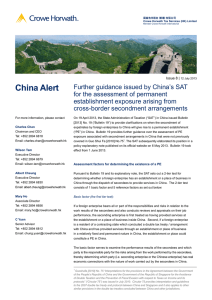Top 10 Mistakes When Performing Discounted Cash Flow
advertisement
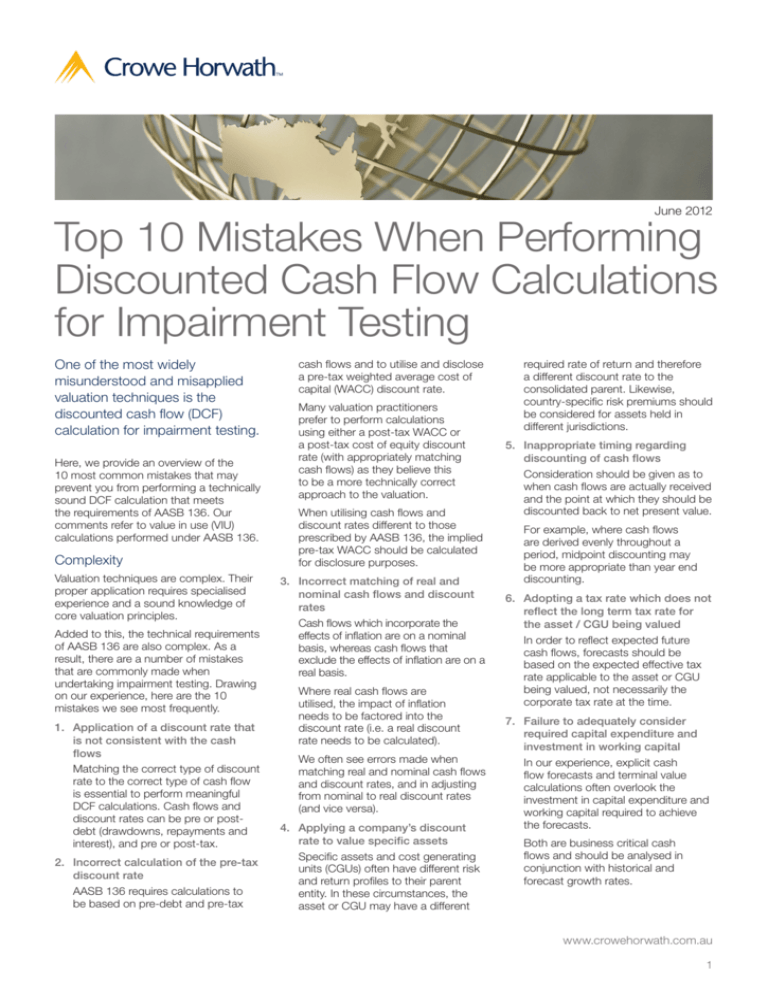
June 2012 Top 10 Mistakes When Performing Discounted Cash Flow Calculations for Impairment Testing One of the most widely misunderstood and misapplied valuation techniques is the discounted cash flow (DCF) calculation for impairment testing. Here, we provide an overview of the 10 most common mistakes that may prevent you from performing a technically sound DCF calculation that meets the requirements of AASB 136. Our comments refer to value in use (VIU) calculations performed under AASB 136. cash flows and to utilise and disclose a pre-tax weighted average cost of capital (WACC) discount rate. Complexity Valuation techniques are complex. Their proper application requires specialised experience and a sound knowledge of core valuation principles. Added to this, the technical requirements of AASB 136 are also complex. As a result, there are a number of mistakes that are commonly made when undertaking impairment testing. Drawing on our experience, here are the 10 mistakes we see most frequently. 1. Application of a discount rate that is not consistent with the cash flows Matching the correct type of discount rate to the correct type of cash flow is essential to perform meaningful DCF calculations. Cash flows and discount rates can be pre or postdebt (drawdowns, repayments and interest), and pre or post-tax. 2. Incorrect calculation of the pre-tax discount rate AASB 136 requires calculations to be based on pre-debt and pre-tax Many valuation practitioners prefer to perform calculations using either a post-tax WACC or a post-tax cost of equity discount rate (with appropriately matching cash flows) as they believe this to be a more technically correct approach to the valuation. When utilising cash flows and discount rates different to those prescribed by AASB 136, the implied pre-tax WACC should be calculated for disclosure purposes. 3. Incorrect matching of real and nominal cash flows and discount rates Cash flows which incorporate the effects of inflation are on a nominal basis, whereas cash flows that exclude the effects of inflation are on a real basis. Where real cash flows are utilised, the impact of inflation needs to be factored into the discount rate (i.e. a real discount rate needs to be calculated). We often see errors made when matching real and nominal cash flows and discount rates, and in adjusting from nominal to real discount rates (and vice versa). 4. Applying a company’s discount rate to value specific assets Specific assets and cost generating units (CGUs) often have different risk and return profiles to their parent entity. In these circumstances, the asset or CGU may have a different required rate of return and therefore a different discount rate to the consolidated parent. Likewise, country-specific risk premiums should be considered for assets held in different jurisdictions. 5. Inappropriate timing regarding discounting of cash flows Consideration should be given as to when cash flows are actually received and the point at which they should be discounted back to net present value. For example, where cash flows are derived evenly throughout a period, midpoint discounting may be more appropriate than year end discounting. 6. Adopting a tax rate which does not reflect the long term tax rate for the asset / CGU being valued In order to reflect expected future cash flows, forecasts should be based on the expected effective tax rate applicable to the asset or CGU being valued, not necessarily the corporate tax rate at the time. 7. Failure to adequately consider required capital expenditure and investment in working capital In our experience, explicit cash flow forecasts and terminal value calculations often overlook the investment in capital expenditure and working capital required to achieve the forecasts. Both are business critical cash flows and should be analysed in conjunction with historical and forecast growth rates. www.crowehorwath.com.au 1 Top 10 Mistakes When Performing Discounted Cash Flow Calculations for Impairment Testing For Further Information Please contact your local advisor: Andrew Fressl Principal Corporate Finance Sydney Tel +61 2 9619 1669 Mobile 0416 212 093 andrew.fressl@crowehorwath.com.au Nathan Timosevski Manager Corporate Finance Sydney Tel +61 2 9619 1783 Mobile 0421 890 973 nathan.timosevski@crowehorwath.com.au Lachlan McColl Senior Manager Corporate Finance Melbourne Tel +61 3 5224 7753 Mobile 0402 040 702 lachlan.mccoll@crowehorwath.com.au Harley Mitchell Principal Corporate Finance Brisbane Tel +61 7 3233 3501 Mobile 0408 115 453 harley.mitchell@crowehorwath.com.au Darryl Norville Principal Corporate Finance Perth Tel +61 8 9481 1448 Mobile 0403 153 193 darryl.norville@crowehorwath.com.au 8. Misapplication of the constant growth perpetuity formula in calculating a terminal value The constant growth perpetuity formula is highly sensitive to the variables adopted, particularly to the growth rate adopted. To avoid any doubt, the growth rate adopted implies a level of growth into perpetuity. Perpetual growth rates that are higher than long term industry growth rates or significantly higher than forecast inflation rates may be unrealistic and may overstate value. We recommend that when terminal values are calculated using this method, they are cross-checked to implied earnings multiples. 9. Confusion over whether the valuation outputs reflect a geared or un-geared valuation Depending on the type of cash flows and discount rate adopted, the valuation outcome should reflect either an un-geared or a geared valuation. In other words, the VIU calculated will be either before or after debt. Failing to understand whether the VIU calculated is before or after debt can lead to major errors in assessing whether impairment has occurred. 10.Inappropriate application of implied multiple cross checks In our experience, price earnings multiples are often confused with EBIT and EBITDA multiples. Consequently: n implied multiples are either calculated incorrectly; or n the implied multiple is incorrectly compared to a different type of benchmark multiple. Importantly, a price earnings multiple is a geared multiple (multiple of equity value), whereas EBIT and EBITDA multiples are un-geared multiples (multiples of enterprise value). Where to Next? If you require assistance with impairment testing calculations, please contact our valuation team at Crowe Horwath. Our valuation team provides valuations of businesses, shares and other securities to assist shareholders, management teams and Boards to analyse merger and acquisition transactions and to make decisions around landmark events, including the preparation of public and listed company Independent Expert’s Reports. Crowe Horwath in Australia Crowe Horwath works with companies and individuals to maximise their growth potential and achieve financial goals. The firm’s team of more than 800 Principals and professionals delivers a full range of accounting including, audit and taxation, business advisory, corporate finance and wealth management services nationally from offices in Brisbane, Melbourne, Perth and Sydney. Crowe Horwath is an integral part of the ASX-listed WHK Group – Australia’s fifth largest accounting services group – and a member of the global Crowe Horwath International network. Crowe Horwath International is ranked among the world’s top-ten accounting networks and comprises more than 140 independent accounting and advisory services firms in more than 100 countries. See www.crowehorwath.com.au. The relationship you can count on Crowe Horwath Corporate Finance Ltd is a member of Crowe Horwath International, a Swiss verein. Each member firm of Crowe Horwath is a separate and independent legal entity. Crowe Horwath Corporate Finance Ltd and its affiliates are not responsible or liable for any acts or omissions of Crowe Horwath or any other member of Crowe Horwath and specifically disclaim any and all responsibility or liability for acts or omissions of Crowe Horwath or any other Crowe Horwath member. The information contained within this document was compiled by Crowe Horwath Corporate Finance Ltd (CHCF) based on materials from other sources and no warranty regarding the accuracy or completeness of the information is provided. All opinions, conclusions, forecasts or recommendations are reasonably held at the time of compilation but are subject to change without notice by CHCF. CHCF assume no obligation to update this document after it has been issued. Except for any liability which by law cannot be excluded, CHCF/WHK Group Limited, its Directors, employees and agents disclaim all liability (whether in negligence or otherwise) for any error, inaccuracy in, or omission from the information contained in this document or any loss or damage suffered by the recipient or any other person directly or indirectly through relying upon the information. This publication is intended to provide background information only and does not purport to make any recommendation upon which you may reasonably rely without taking further advice. This publication does not take into account any person’s investment objectives, financial situation and particular needs. Should you consider the acquisition of a particular financial product as a result of the material contained, you should obtain a copy of and consider the Product Disclosure Statement (where applicable) for that product before making any decision. CHCF may receive a fee for advice and/or the implementation of an investment decision. CHCF and their representatives may have financial interests in some/any of the product(s) included within this report. Crowe Horwath Corporate Finance Ltd is the holder of an Australian Financial Services Licence – No: 239170, ABN 95 001 508 363 – a WHK Group firm. www.crowehorwath.com.au 2
